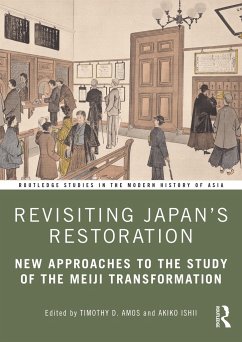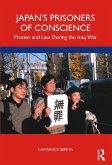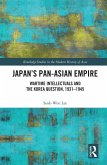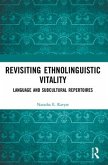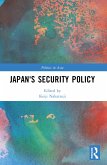Revisiting Japan's Restoration
New Approaches to the Study of the Meiji Transformation
Herausgeber: Ishii, Akiko; Amos, Timothy
Revisiting Japan's Restoration
New Approaches to the Study of the Meiji Transformation
Herausgeber: Ishii, Akiko; Amos, Timothy
- Broschiertes Buch
- Merkliste
- Auf die Merkliste
- Bewerten Bewerten
- Teilen
- Produkt teilen
- Produkterinnerung
- Produkterinnerung
A collection of succinct, accessible and varied analyses, offering the most comprehensive view of the Meiji Restoration ever compiled in the English language.
Andere Kunden interessierten sich auch für
![Fighting Japan's Cold War Fighting Japan's Cold War]() Ryuji HattoriFighting Japan's Cold War144,99 €
Ryuji HattoriFighting Japan's Cold War144,99 €![Japan's Prisoners of Conscience Japan's Prisoners of Conscience]() Lawrence RepetaJapan's Prisoners of Conscience44,99 €
Lawrence RepetaJapan's Prisoners of Conscience44,99 €![Examining Japan's Lost Decades Examining Japan's Lost Decades]() Examining Japan's Lost Decades66,99 €
Examining Japan's Lost Decades66,99 €![Japan's Pan-Asian Empire Japan's Pan-Asian Empire]() Seok-Won LeeJapan's Pan-Asian Empire38,99 €
Seok-Won LeeJapan's Pan-Asian Empire38,99 €![Revisiting Ethnolinguistic Vitality Revisiting Ethnolinguistic Vitality]() Natasha E. Ravyse (South Africa. North West University)Revisiting Ethnolinguistic Vitality49,99 €
Natasha E. Ravyse (South Africa. North West University)Revisiting Ethnolinguistic Vitality49,99 €![Japan's Security Policy Japan's Security Policy]() Japan's Security Policy44,99 €
Japan's Security Policy44,99 €![Japan's Threat Perception during the Cold War Japan's Threat Perception during the Cold War]() Eitan OrenJapan's Threat Perception during the Cold War144,99 €
Eitan OrenJapan's Threat Perception during the Cold War144,99 €-
-
-
A collection of succinct, accessible and varied analyses, offering the most comprehensive view of the Meiji Restoration ever compiled in the English language.
Produktdetails
- Produktdetails
- Routledge Studies in the Modern History of Asia
- Verlag: Taylor & Francis Ltd
- Seitenzahl: 312
- Erscheinungstermin: 30. November 2021
- Englisch
- Abmessung: 441mm x 245mm x 22mm
- Gewicht: 558g
- ISBN-13: 9781032075785
- ISBN-10: 1032075783
- Artikelnr.: 62799683
- Routledge Studies in the Modern History of Asia
- Verlag: Taylor & Francis Ltd
- Seitenzahl: 312
- Erscheinungstermin: 30. November 2021
- Englisch
- Abmessung: 441mm x 245mm x 22mm
- Gewicht: 558g
- ISBN-13: 9781032075785
- ISBN-10: 1032075783
- Artikelnr.: 62799683
Timothy D. Amos is Associate Professor in Japanese Studies at the National University of Singapore. His research focuses on marginality in Japan from the early modern period through to the present. He recently published Caste in Early Modern Japan: Danzaemon and the Edo Outcaste Order in Eastern Japan (Routledge, 2020). Akiko Ishii is Research Fellow at the Department of Japanese Studies at the National University of Singapore. Her research focuses on the concepts of population and development in early modern and modern Japan.
IntroductionPart One: World1.The Meiji Restoration and the Long Nineteenth
Century 2. Local Labour and the Trajectory of the Meiji Restoration 3.
Freedom, Slavery and the Meiji Restoration, Revisiting the Maria Luz
Incident Part Two: Governance4. The Meiji Restoration and Governmnetality
5.Rulings on Tokagawa Status Infringements and Local Governing Practices in
Early Meiji Osaka Court Records Part Three: Asia6. From Boy Emperors to
Business Opportunities: Glimpses of the Meiji Restoration from the China
Coast Press c1868-70 7. Reformists and Revolutionaries: Filipinos View
Meiji Japan, 1880s-2000s 8. Ealy 20th Century Vietnamese Intellectuals'
Perceptions of the Meiji Restoration and its Lessons for Manpower
Cultivation Part Four: Ideas9. Questioning Modernity: A Historiographical
Sketch of the Meiji Enlightenment 10. The "Meiji Restoration as Ideal and
Failure: The Spectre of a Second Innovation Part Five: Nation-Empire11.
Meiji and the Bonin Islands: Ambiguous Bodies and Ambivalent Borders 12.
Reconstructing State-Formation and Empire-Building in Meiji Japan Part Six:
Culture13. Inventing Ise in Meiji Japan 14. Haikai Time in Meiji Japan 15.
Tokugawa v. Meiji: A Nocturnal Interpretation Part Seven: Medicine and
Health16. Blood, Bandages, and Bickering: Doctors in the Boshin War 17.
Toward Creating New Mind, New Body: Yojo as a Late Meiji Ideology Part
Seven: Gender and Status18. The Meiji Restoration as Social History: With a
Focus on Tokyo 19. Cattle Plague, Livestock Disposal, and the Dismantling
of the Early Modern Status Order 20. Kaih¿rei kara Suihei Sengen e -- From
Emancipation by the State to Liberation by Our Own Efforts Part Eight:
Production and Consumption21. From Ramune to Ryokucha: Continuities and
Discontinuities in Japanese Beverage Consumption 22. Post-Restoration
Transformations and Merchant Guilds: The Oil Seed Merchants of Osaka Part
Nine: Region and Locality23. The Meiji Restoration and Local History:
Reflections Based on Osaka's Izumi Region 24. Traditional Culture and
Modern Administration: The Meiji Government's Hot Spring Policy and Local
Community 25. Whose Restoration? Observations from a Study of the Kagoshima
Teacher Training School, 1875-1877 Part Ten: Urban Space26. The World of
the Pleasure Quarters in the Transitional Period from Early Modern to
Modern Japan: Research on the Yokohama Pleasure Quarters 27. Changes in the
Regulation of Unlicensed Prostitutes in the Ansei Period (1854-1860) and
"Horie-Shinchi" Part Eleven: Modernity28. The Words of Modernity before
Modernity 29.The Background of Japan's Modernization: What made the Meiji
Restoration Possible? Part Twelve:Politics30. February 11, 1889: The Birth
of Modern Japan 31. From Shogunal Benevolence to Monarchial Compassion: The
Shifting Status of "Voices from the Bottom" in the Meiji Restoration
Century 2. Local Labour and the Trajectory of the Meiji Restoration 3.
Freedom, Slavery and the Meiji Restoration, Revisiting the Maria Luz
Incident Part Two: Governance4. The Meiji Restoration and Governmnetality
5.Rulings on Tokagawa Status Infringements and Local Governing Practices in
Early Meiji Osaka Court Records Part Three: Asia6. From Boy Emperors to
Business Opportunities: Glimpses of the Meiji Restoration from the China
Coast Press c1868-70 7. Reformists and Revolutionaries: Filipinos View
Meiji Japan, 1880s-2000s 8. Ealy 20th Century Vietnamese Intellectuals'
Perceptions of the Meiji Restoration and its Lessons for Manpower
Cultivation Part Four: Ideas9. Questioning Modernity: A Historiographical
Sketch of the Meiji Enlightenment 10. The "Meiji Restoration as Ideal and
Failure: The Spectre of a Second Innovation Part Five: Nation-Empire11.
Meiji and the Bonin Islands: Ambiguous Bodies and Ambivalent Borders 12.
Reconstructing State-Formation and Empire-Building in Meiji Japan Part Six:
Culture13. Inventing Ise in Meiji Japan 14. Haikai Time in Meiji Japan 15.
Tokugawa v. Meiji: A Nocturnal Interpretation Part Seven: Medicine and
Health16. Blood, Bandages, and Bickering: Doctors in the Boshin War 17.
Toward Creating New Mind, New Body: Yojo as a Late Meiji Ideology Part
Seven: Gender and Status18. The Meiji Restoration as Social History: With a
Focus on Tokyo 19. Cattle Plague, Livestock Disposal, and the Dismantling
of the Early Modern Status Order 20. Kaih¿rei kara Suihei Sengen e -- From
Emancipation by the State to Liberation by Our Own Efforts Part Eight:
Production and Consumption21. From Ramune to Ryokucha: Continuities and
Discontinuities in Japanese Beverage Consumption 22. Post-Restoration
Transformations and Merchant Guilds: The Oil Seed Merchants of Osaka Part
Nine: Region and Locality23. The Meiji Restoration and Local History:
Reflections Based on Osaka's Izumi Region 24. Traditional Culture and
Modern Administration: The Meiji Government's Hot Spring Policy and Local
Community 25. Whose Restoration? Observations from a Study of the Kagoshima
Teacher Training School, 1875-1877 Part Ten: Urban Space26. The World of
the Pleasure Quarters in the Transitional Period from Early Modern to
Modern Japan: Research on the Yokohama Pleasure Quarters 27. Changes in the
Regulation of Unlicensed Prostitutes in the Ansei Period (1854-1860) and
"Horie-Shinchi" Part Eleven: Modernity28. The Words of Modernity before
Modernity 29.The Background of Japan's Modernization: What made the Meiji
Restoration Possible? Part Twelve:Politics30. February 11, 1889: The Birth
of Modern Japan 31. From Shogunal Benevolence to Monarchial Compassion: The
Shifting Status of "Voices from the Bottom" in the Meiji Restoration
IntroductionPart One: World1.The Meiji Restoration and the Long Nineteenth
Century 2. Local Labour and the Trajectory of the Meiji Restoration 3.
Freedom, Slavery and the Meiji Restoration, Revisiting the Maria Luz
Incident Part Two: Governance4. The Meiji Restoration and Governmnetality
5.Rulings on Tokagawa Status Infringements and Local Governing Practices in
Early Meiji Osaka Court Records Part Three: Asia6. From Boy Emperors to
Business Opportunities: Glimpses of the Meiji Restoration from the China
Coast Press c1868-70 7. Reformists and Revolutionaries: Filipinos View
Meiji Japan, 1880s-2000s 8. Ealy 20th Century Vietnamese Intellectuals'
Perceptions of the Meiji Restoration and its Lessons for Manpower
Cultivation Part Four: Ideas9. Questioning Modernity: A Historiographical
Sketch of the Meiji Enlightenment 10. The "Meiji Restoration as Ideal and
Failure: The Spectre of a Second Innovation Part Five: Nation-Empire11.
Meiji and the Bonin Islands: Ambiguous Bodies and Ambivalent Borders 12.
Reconstructing State-Formation and Empire-Building in Meiji Japan Part Six:
Culture13. Inventing Ise in Meiji Japan 14. Haikai Time in Meiji Japan 15.
Tokugawa v. Meiji: A Nocturnal Interpretation Part Seven: Medicine and
Health16. Blood, Bandages, and Bickering: Doctors in the Boshin War 17.
Toward Creating New Mind, New Body: Yojo as a Late Meiji Ideology Part
Seven: Gender and Status18. The Meiji Restoration as Social History: With a
Focus on Tokyo 19. Cattle Plague, Livestock Disposal, and the Dismantling
of the Early Modern Status Order 20. Kaih¿rei kara Suihei Sengen e -- From
Emancipation by the State to Liberation by Our Own Efforts Part Eight:
Production and Consumption21. From Ramune to Ryokucha: Continuities and
Discontinuities in Japanese Beverage Consumption 22. Post-Restoration
Transformations and Merchant Guilds: The Oil Seed Merchants of Osaka Part
Nine: Region and Locality23. The Meiji Restoration and Local History:
Reflections Based on Osaka's Izumi Region 24. Traditional Culture and
Modern Administration: The Meiji Government's Hot Spring Policy and Local
Community 25. Whose Restoration? Observations from a Study of the Kagoshima
Teacher Training School, 1875-1877 Part Ten: Urban Space26. The World of
the Pleasure Quarters in the Transitional Period from Early Modern to
Modern Japan: Research on the Yokohama Pleasure Quarters 27. Changes in the
Regulation of Unlicensed Prostitutes in the Ansei Period (1854-1860) and
"Horie-Shinchi" Part Eleven: Modernity28. The Words of Modernity before
Modernity 29.The Background of Japan's Modernization: What made the Meiji
Restoration Possible? Part Twelve:Politics30. February 11, 1889: The Birth
of Modern Japan 31. From Shogunal Benevolence to Monarchial Compassion: The
Shifting Status of "Voices from the Bottom" in the Meiji Restoration
Century 2. Local Labour and the Trajectory of the Meiji Restoration 3.
Freedom, Slavery and the Meiji Restoration, Revisiting the Maria Luz
Incident Part Two: Governance4. The Meiji Restoration and Governmnetality
5.Rulings on Tokagawa Status Infringements and Local Governing Practices in
Early Meiji Osaka Court Records Part Three: Asia6. From Boy Emperors to
Business Opportunities: Glimpses of the Meiji Restoration from the China
Coast Press c1868-70 7. Reformists and Revolutionaries: Filipinos View
Meiji Japan, 1880s-2000s 8. Ealy 20th Century Vietnamese Intellectuals'
Perceptions of the Meiji Restoration and its Lessons for Manpower
Cultivation Part Four: Ideas9. Questioning Modernity: A Historiographical
Sketch of the Meiji Enlightenment 10. The "Meiji Restoration as Ideal and
Failure: The Spectre of a Second Innovation Part Five: Nation-Empire11.
Meiji and the Bonin Islands: Ambiguous Bodies and Ambivalent Borders 12.
Reconstructing State-Formation and Empire-Building in Meiji Japan Part Six:
Culture13. Inventing Ise in Meiji Japan 14. Haikai Time in Meiji Japan 15.
Tokugawa v. Meiji: A Nocturnal Interpretation Part Seven: Medicine and
Health16. Blood, Bandages, and Bickering: Doctors in the Boshin War 17.
Toward Creating New Mind, New Body: Yojo as a Late Meiji Ideology Part
Seven: Gender and Status18. The Meiji Restoration as Social History: With a
Focus on Tokyo 19. Cattle Plague, Livestock Disposal, and the Dismantling
of the Early Modern Status Order 20. Kaih¿rei kara Suihei Sengen e -- From
Emancipation by the State to Liberation by Our Own Efforts Part Eight:
Production and Consumption21. From Ramune to Ryokucha: Continuities and
Discontinuities in Japanese Beverage Consumption 22. Post-Restoration
Transformations and Merchant Guilds: The Oil Seed Merchants of Osaka Part
Nine: Region and Locality23. The Meiji Restoration and Local History:
Reflections Based on Osaka's Izumi Region 24. Traditional Culture and
Modern Administration: The Meiji Government's Hot Spring Policy and Local
Community 25. Whose Restoration? Observations from a Study of the Kagoshima
Teacher Training School, 1875-1877 Part Ten: Urban Space26. The World of
the Pleasure Quarters in the Transitional Period from Early Modern to
Modern Japan: Research on the Yokohama Pleasure Quarters 27. Changes in the
Regulation of Unlicensed Prostitutes in the Ansei Period (1854-1860) and
"Horie-Shinchi" Part Eleven: Modernity28. The Words of Modernity before
Modernity 29.The Background of Japan's Modernization: What made the Meiji
Restoration Possible? Part Twelve:Politics30. February 11, 1889: The Birth
of Modern Japan 31. From Shogunal Benevolence to Monarchial Compassion: The
Shifting Status of "Voices from the Bottom" in the Meiji Restoration

